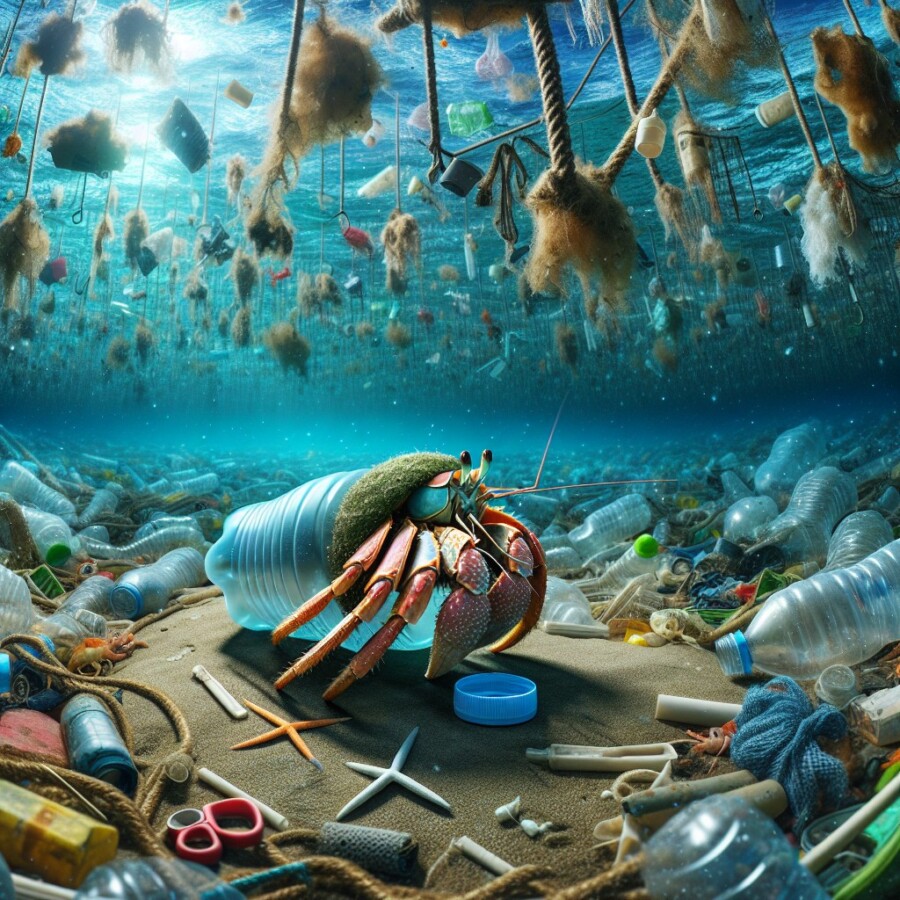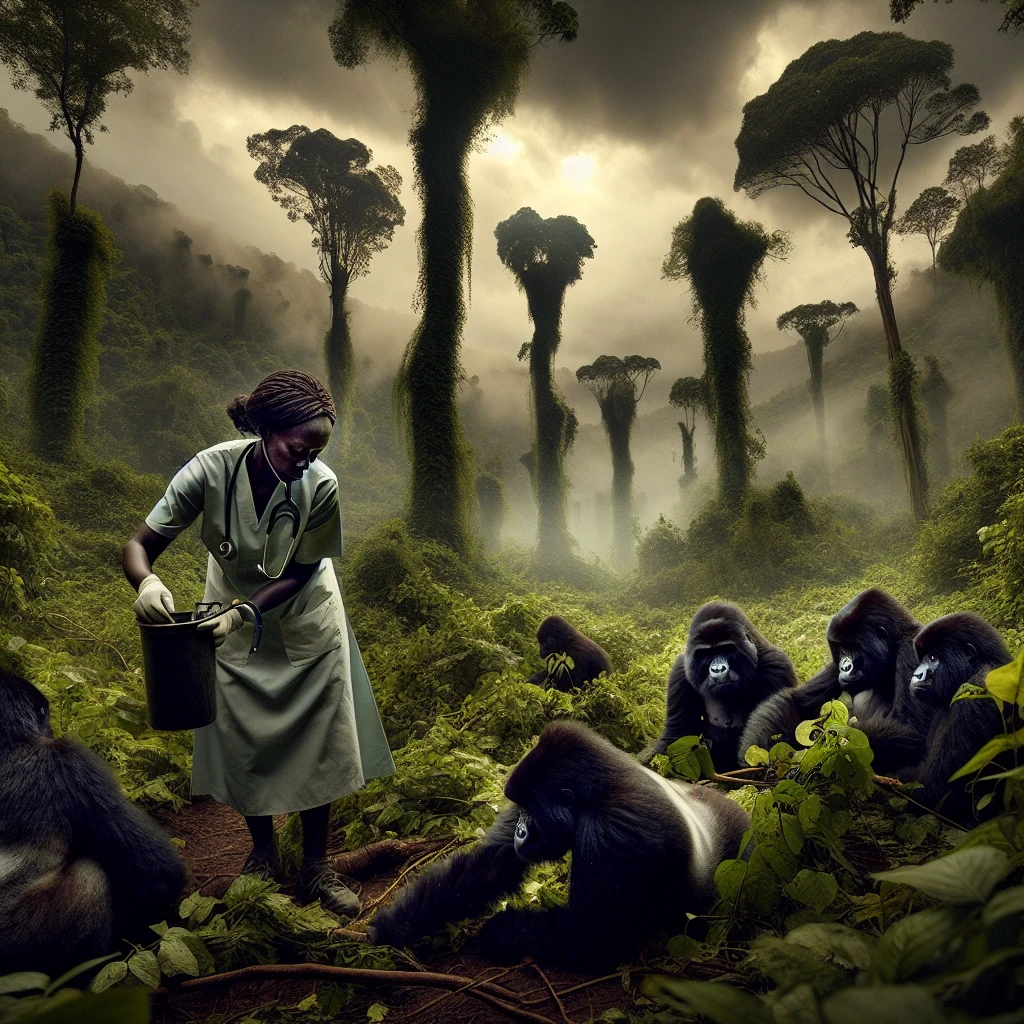Hermit crabs, which typically use shells as protection, are increasingly turning to plastic waste instead. This conclusion is based on an analysis of photographs taken by wildlife enthusiasts and shared online. Scientists were saddened to see the extent to which these animals were living in our rubbish. The study, published in the journal Science of the Total Environment, used social media and photo-sharing websites to gather data. The researchers found that two-thirds of hermit crab species were pictured using artificial shells, mainly made of plastic.
The researchers discovered a total of 386 hermit crabs using plastic caps as shells. They also found that 10 out of the 16 species of land hermit crabs worldwide use this type of shelter. However, it is still unclear whether these materials are harmful or beneficial to the crabs. The researchers are interested in understanding how these coastal crustaceans interact with and use plastic, as well as how it might affect their evolution.
The use of artificial shells by hermit crabs is a global phenomenon, observed in two-thirds of all terrestrial hermit crab species. The researchers want to investigate whether the crabs will fight over plastic shells, as they do over natural snail shells. The decline in natural snail shells may make it easier for the crabs to find artificial alternatives. Additionally, lighter plastic shells may even help smaller and weaker crabs survive, as they are easier to carry.
There is a significant amount of plastic in the marine environment for the crabs to choose from. A recent study estimated that at least 171 trillion pieces of plastic are floating in our oceans, and this number could triple by 2040 if no action is taken. However, there is hope that a global treaty to address plastic pollution will be signed in 2024. Mark Miodownik, a professor of materials and society, suggests that humans should learn from the hermit crabs and reuse plastics instead of discarding them.
Original news source: Hermit crabs are ‘wearing’ our plastic rubbish (BBC)
🎧 Listen:
Slow
Normal
Fast
📖 Vocabulary:
| 1 | hermit | A person living in solitude or a reclusive creature |
| 2 | analysis | The detailed examination or study of something |
| 3 | enthusiasts | Individuals with a keen interest in a particular activity or subject |
| 4 | extent | The degree or scope of something |
| 5 | rubbish | Waste material or garbage |
| 6 | artificial | Made or produced by human beings rather than occurring naturally |
| 7 | crustaceans | Aquatic animals with a hard shell and jointed limbs |
| 8 | evolution | The gradual development of something, especially from a simple to a more complex form |
| 9 | phenomenon | An observable occurrence or event that is remarkable or unusual |
| 10 | terrestrial | Relating to or existing on the land as opposed to in water or air |
| 11 | alternatives | Options or choices that can be used as substitutes |
| 12 | marine | Relating to the sea or ocean |
| 13 | estimated | Calculated approximately or judged |
| 14 | treaty | A formal agreement between countries |
| 15 | discard | To throw away or get rid of something as no longer useful or desirable |
Group or Classroom Activities
Warm-up Activities:
– Charades
Instructions: Divide the class into two teams. Give each team a set of vocabulary words related to the article (e.g. hermit crab, plastic waste, artificial shells). One student from each team will come to the front of the class and act out the word without speaking. The team members must guess the word within a certain time limit. The team that guesses the most words correctly wins.
– News Summary
Instructions: In pairs or small groups, students will take turns summarizing the article in their own words. They should include the main points and key details. After each summary, the other students can ask questions to clarify any points they didn’t understand. This activity helps students practice their summarizing and speaking skills.
– Opinion Poll
Instructions: Create a list of statements related to the article (e.g. Plastic waste is harmful to hermit crabs, Reusing plastics is a good solution to the pollution problem). Have students walk around the classroom and ask their classmates for their opinions on each statement. They should record their classmates’ responses and be prepared to share the results with the class. This activity encourages students to engage in discussions and express their opinions.
– Vocabulary Pictionary
Instructions: Give each student a vocabulary word from the article (e.g. hermit crab, plastic waste, artificial shells). They should draw a picture that represents the word without using any letters or numbers. The other students must guess the word based on the drawing. This activity helps students practice their vocabulary and visual communication skills.
– Future Predictions
Instructions: In pairs or small groups, students will discuss and make predictions about the future of hermit crabs and plastic waste. They should consider the potential impact of plastic pollution on hermit crab populations and their habitats. After the discussion, each group will share their predictions with the class. This activity encourages critical thinking and speculation about future scenarios.
🤔 Comprehension Questions:
1. How did scientists gather data for the study on hermit crabs using plastic waste?
2. What percentage of hermit crab species were observed using artificial shells made of plastic?
3. How many hermit crabs were found using plastic caps as shells in the study?
4. What is still unclear about the use of plastic shells by hermit crabs?
5. What do the researchers want to investigate regarding the use of plastic shells by hermit crabs?
6. How might the decline in natural snail shells affect the use of plastic shells by hermit crabs?
7. How much plastic is estimated to be floating in our oceans according to a recent study?
8. What suggestion does Professor Mark Miodownik make regarding plastic waste based on the study on hermit crabs?
Go to answers ⇩
🎧✍️ Listen and Fill in the Gaps:
Hermit crabs, which typically use shells as (1)______, are increasingly turning to plastic waste instead. This conclusion is based on an (2)______ of photographs taken by wildlife enthusiasts and shared online. Scientists were saddened to see the extent to which these animals were living in our rubbish. The study, published in the journal Science of the (3)______ Environment, used (4)______ media and photo-sharing websites to gather data. The researchers found that two-thirds of hermit crab species were (5)______ using artificial shells, mainly made of plastic.
The researchers discovered a total of 386 hermit crabs using plastic caps as shells. They also found that 10 out of the 16 species of land hermit crabs worldwide use this type of shelter. However, it is still unclear whether these materials are harmful or beneficial to the crabs. The researchers are interested in understanding how these (6)______ crustaceans (7)______ with and use plastic, as well as how it might (8)______ their evolution.
The use of artificial shells by (9)______ (10)______ is a global (11)______, observed in two-thirds of all terrestrial hermit crab species. The researchers want to investigate whether the crabs will fight over plastic shells, as they do over natural snail shells. The decline in natural snail shells may make it easier for the crabs to find artificial alternatives. Additionally, (12)______ plastic shells may even help smaller and weaker crabs survive, as they are easier to carry.
There is a significant amount of (13)______ in the (14)______ environment for the crabs to choose from. A recent study estimated that at least 171 trillion (15)______ of plastic are floating in our oceans, and this number could triple by 2040 if no action is taken. However, there is hope that a global treaty to address plastic pollution will be signed in 2024. Mark Miodownik, a professor of materials and society, suggests that humans should learn from the hermit crabs and reuse (16)______ instead of discarding them.
Go to answers ⇩
💬 Discussion Questions:
Students can ask a partner these questions, or discuss them as a group.
1. What is a hermit crab and why do they use shells for protection?
2. How would you feel if you saw animals living in plastic waste?
3. Do you think it is concerning that two-thirds of hermit crab species are using plastic shells? Why or why not?
4. Why do you think hermit crabs are choosing plastic shells instead of natural snail shells?
5. How do you think the use of plastic shells might affect the evolution of hermit crabs?
6. Do you think hermit crabs will fight over plastic shells like they do over natural snail shells? Why or why not?
7. How do you think the decline in natural snail shells might impact hermit crab populations?
8. Do you like the idea of humans reusing plastics instead of discarding them? Why or why not?
9. How do you think the abundance of plastic in the marine environment is affecting marine life?
10. Why do you think there is hope that a global treaty to address plastic pollution will be signed in 2024?
11. How do you think the increasing amount of plastic in our oceans will impact the planet in the future?
12. Do you think humans should be more responsible for their plastic waste? Why or why not?
13. How do you think the use of plastic shells by hermit crabs reflects the impact of human activity on the environment?
14. What steps do you think individuals can take to reduce plastic pollution in the oceans?
15. How do you think the use of plastic shells by hermit crabs highlights the need for environmental conservation and protection?
Individual Activities
📖💭 Vocabulary Meanings:
Match each word to its meaning.
Words:
1. hermit
2. analysis
3. enthusiasts
4. extent
5. rubbish
6. artificial
7. crustaceans
8. evolution
9. phenomenon
10. terrestrial
11. alternatives
12. marine
13. estimated
14. treaty
15. discard
Meanings:
(A) Relating to or existing on the land as opposed to in water or air
(B) Made or produced by human beings rather than occurring naturally
(C) Options or choices that can be used as substitutes
(D) Waste material or garbage
(E) Individuals with a keen interest in a particular activity or subject
(F) Calculated approximately or judged
(G) To throw away or get rid of something as no longer useful or desirable
(H) An observable occurrence or event that is remarkable or unusual
(I) Relating to the sea or ocean
(J) The detailed examination or study of something
(K) A person living in solitude or a reclusive creature
(L) The degree or scope of something
(M) Aquatic animals with a hard shell and jointed limbs
(N) The gradual development of something, especially from a simple to a more complex form
(O) A formal agreement between countries
Go to answers ⇩
🔡 Multiple Choice Questions:
1. What did the study find about hermit crabs and their use of shells?
(a) They only use natural snail shells as protection.
(b) They are increasingly using plastic waste as shells.
(c) They do not use any type of shells for protection.
(d) They are not affected by the presence of plastic waste.
2. How did the researchers gather data for the study?
(a) They conducted experiments in a laboratory.
(b) They observed hermit crabs in their natural habitats.
(c) They interviewed wildlife enthusiasts in person.
(d) They used social media and photo-sharing websites.
3. How many hermit crabs were found using plastic caps as shells?
(a) 16
(b) 10
(c) 386
(d) 2/3
4. What is still unclear about the use of plastic shells by hermit crabs?
(a) Whether they are harmful or beneficial to the crabs.
(b) Whether they are more durable than natural snail shells.
(c) Whether they are preferred over other types of artificial shells.
(d) Whether they are a recent phenomenon or have always been used.
5. What do the researchers want to investigate about hermit crabs and plastic shells?
(a) Whether the crabs will abandon natural snail shells completely.
(b) Whether the crabs will fight over them.
(c) Whether the crabs will use them as nesting sites.
(d) Whether the crabs will use them as food sources.
6. What is a potential benefit of hermit crabs using plastic shells?
(a) Smaller and weaker crabs may be able to survive easier.
(b) They will have a wider variety of shells to choose from.
(c) They will be able to build stronger and more durable shells.
(d) They will be less likely to be preyed upon by other animals.
7. How much plastic is estimated to be floating in our oceans?
(a) 386 pieces.
(b) 16 pieces.
(c) 2/3 of all plastic waste.
(d) At least 171 trillion pieces.
8. What is the hope for addressing plastic pollution?
(a) Hermit crabs will find alternative materials for shells.
(b) Humans will stop using plastic altogether.
(c) A global treaty will be signed in 2024.
(d) The number of plastic pieces in the ocean will decrease by 2040.
Go to answers ⇩
🕵️ True or False Questions:
1. Hermit crabs are rarely using plastic waste as protection instead of shells.
2. The conclusion is based on an analysis of photographs taken by wildlife enthusiasts and shared online.
3. A total of 386 hermit crabs were found using plastic caps as shells.
4. A recent study estimated that less than 171 trillion pieces of plastic are floating in our oceans, and this number could decrease by 2040 if no action is taken.
5. Two-thirds of hermit crab species were pictured using artificial shells, mainly made of plastic.
6. 10 out of the 16 species of land hermit crabs worldwide use plastic shells.
7. The decline in natural snail shells may make it harder for crabs to find artificial alternatives.
8. It is absolutely clear whether plastic shells are harmful or beneficial to the crabs.
Go to answers ⇩
📝 Write a Summary:
Write a summary of this news article in two sentences.
Writing Questions:
Answer the following questions. Write as much as you can for each answer.
1. What is the main finding of the study regarding hermit crabs and their use of shells?
2. How did the researchers gather data for their study on hermit crabs?
3. What is still unclear about the use of plastic shells by hermit crabs?
4. What are the potential benefits of hermit crabs using plastic shells instead of natural snail shells?
5. How much plastic is estimated to be floating in our oceans, and what is the potential impact if no action is taken?
✅ Answers
🤔✅ Comprehension Question Answers:
1. How did scientists gather data for the study on hermit crabs using plastic waste?
The scientists used social media and photo-sharing websites to gather data.
2. What percentage of hermit crab species were observed using artificial shells made of plastic?
Two-thirds (or 66.7%) of hermit crab species were observed using artificial shells made of plastic.
3. How many hermit crabs were found using plastic caps as shells in the study?
A total of 386 hermit crabs were found using plastic caps as shells in the study.
4. What is still unclear about the use of plastic shells by hermit crabs?
It is still unclear whether these materials are harmful or beneficial to the crabs.
5. What do the researchers want to investigate regarding the use of plastic shells by hermit crabs?
The researchers want to investigate whether the crabs will fight over plastic shells, as they do over natural snail shells.
6. How might the decline in natural snail shells affect the use of plastic shells by hermit crabs?
The decline in natural snail shells may make it easier for the crabs to find artificial alternatives.
7. How much plastic is estimated to be floating in our oceans according to a recent study?
A recent study estimated that at least 171 trillion pieces of plastic are floating in our oceans.
8. What suggestion does Professor Mark Miodownik make regarding plastic waste based on the study on hermit crabs?
Professor Mark Miodownik suggests that humans should learn from the hermit crabs and reuse plastics instead of discarding them.
Go back to questions ⇧
🎧✍️✅ Listen and Fill in the Gaps Answers:
(1) protection
(2) analysis
(3) Total
(4) social
(5) pictured
(6) coastal
(7) interact
(8) affect
(9) hermit
(10) crabs
(11) phenomenon
(12) lighter
(13) plastic
(14) marine
(15) pieces
(16) plastics
Go back to questions ⇧
📖💭✅ Vocabulary Meanings Answers:
1. hermit
Answer: (K) A person living in solitude or a reclusive creature
2. analysis
Answer: (J) The detailed examination or study of something
3. enthusiasts
Answer: (E) Individuals with a keen interest in a particular activity or subject
4. extent
Answer: (L) The degree or scope of something
5. rubbish
Answer: (D) Waste material or garbage
6. artificial
Answer: (B) Made or produced by human beings rather than occurring naturally
7. crustaceans
Answer: (M) Aquatic animals with a hard shell and jointed limbs
8. evolution
Answer: (N) The gradual development of something, especially from a simple to a more complex form
9. phenomenon
Answer: (H) An observable occurrence or event that is remarkable or unusual
10. terrestrial
Answer: (A) Relating to or existing on the land as opposed to in water or air
11. alternatives
Answer: (C) Options or choices that can be used as substitutes
12. marine
Answer: (I) Relating to the sea or ocean
13. estimated
Answer: (F) Calculated approximately or judged
14. treaty
Answer: (O) A formal agreement between countries
15. discard
Answer: (G) To throw away or get rid of something as no longer useful or desirable
Go back to questions ⇧
🔡✅ Multiple Choice Answers:
1. What did the study find about hermit crabs and their use of shells?
Answer: (b) They are increasingly using plastic waste as shells.
2. How did the researchers gather data for the study?
Answer: (d) They used social media and photo-sharing websites.
3. How many hermit crabs were found using plastic caps as shells?
Answer: (c) 386
4. What is still unclear about the use of plastic shells by hermit crabs?
Answer: (a) Whether they are harmful or beneficial to the crabs.
5. What do the researchers want to investigate about hermit crabs and plastic shells?
Answer: (b) Whether the crabs will fight over them.
6. What is a potential benefit of hermit crabs using plastic shells?
Answer: (a) Smaller and weaker crabs may be able to survive easier.
7. How much plastic is estimated to be floating in our oceans?
Answer: (d) At least 171 trillion pieces.
8. What is the hope for addressing plastic pollution?
Answer: (c) A global treaty will be signed in 2024.
Go back to questions ⇧
🕵️✅ True or False Answers:
1. Hermit crabs are rarely using plastic waste as protection instead of shells. (Answer: False)
2. The conclusion is based on an analysis of photographs taken by wildlife enthusiasts and shared online. (Answer: True)
3. A total of 386 hermit crabs were found using plastic caps as shells. (Answer: True)
4. A recent study estimated that less than 171 trillion pieces of plastic are floating in our oceans, and this number could decrease by 2040 if no action is taken. (Answer: False)
5. Two-thirds of hermit crab species were pictured using artificial shells, mainly made of plastic. (Answer: True)
6. 10 out of the 16 species of land hermit crabs worldwide use plastic shells. (Answer: True)
7. The decline in natural snail shells may make it harder for crabs to find artificial alternatives. (Answer: False)
8. It is absolutely clear whether plastic shells are harmful or beneficial to the crabs. (Answer: False)
Go back to questions ⇧











